Acoustic Source Characterization of Marine Propulsors
Abstract
:1. Introduction
1.1. Underwater Radiated Noise
1.2. Model-Scale Tests
1.3. Numerical Methods
1.4. Acoustic Source Characterization
1.5. The Novelty of the Work
2. Methods
2.1. Complete CHA Simulation Model
2.2. Inverse Source Fit
2.3. Solution Sensitivity of Inverse Source Fit
2.4. The Process for an Equivalent Source Model
- A plausible number and distribution of sources is defined;
- The number and locations of sensor points is chosen;
- Transfer matrix from source points and sensor points is determined. Sources placed in source points are activated one at the time, yielding response/source transfer vectors. This is repeated for all source points yielding the full transfer matrix and then its pseudo-inverse. In this work, BEM is used throughout in “forward” acoustic calculations using Equation (3) from sources to sensors. Matrix calculations, Equations (4)–(6) are most conveniently conducted with MATLAB or similar;
- The equivalent source model is tested using pressures calculated with given (known) source vector. The source vector is determined using the inverse method and compared to the given source vector. Corrections for sensor numbers, locations, etc., are made as needed and the test repeated until the accuracy of inversely determined source vector with respect to the given source vector is sufficient;
- The actual measured or calculated pressure vector is multiplied with the transfer matrix pseudo-inverse. This step yields the equivalent source vector;
- The equivalent source vector is tested in re-producing the measured or calculated pressures. Corrections are made as needed;
- The source model is transferred and used in a different environment as a equivalent source model.
3. Test Case
4. CHA Simulation Results
5. The Equivalent Source Model
6. Discussion
7. Conclusions
Author Contributions
Funding
Institutional Review Board Statement
Informed Consent Statement
Data Availability Statement
Conflicts of Interest
Abbreviations
| BEM | Boundary Element Method |
| BPF | Blade Passing Frequency |
| CFD | Computational Fluid Dynamics |
| CHA | Computational Hydro-acoustics |
| DNS | Direct Numerical Simulation |
| FEM | Finite Element Method |
| PPTC | Potsdam Propeller Test Case |
| SVD | Singular Value Decomposition |
| URN | Underwater Radiated Noise |
References
- Directive, Strategy Framework. Directive 2008/56/EC of the European Parliament and of the Council. Council Decision of 2008. Available online: https://www.legislation.gov.uk/eudr/2008/56/contents (accessed on 5 September 2022).
- van der Graaf, A.J.; Ainslie, M.A.; André, M.; Brensing, K.; Dalen, J.; Dekeling, R.P.A.; Robinson, S.P.; Tasker, M.L.; Thomsen, F.; Werner, S. European Marine Strategy Framework Directive Good Environmental Status (MSFD-GES). Report of the Technical Subgroup on Underwater Noise and Other Forms of Energy; TSG Noise & Milieu Ltd.: Brussels, Belgium, 2012; pp. 1–75. [Google Scholar]
- Mitson, R.B. (Ed.) Underwater Noise of Research Vessels. Review and Recommendations; Cooperative Research Report No. 209 (Issue 209); ICES: Copenhagen, Denmark, 1995. [Google Scholar]
- Colbert, B.R. Trends and developments in international regulation of anthropogenic sound in aquatic habitats. J. Acoust. Soc. Am. 2020, 147, 3100–3107. [Google Scholar] [CrossRef] [PubMed]
- ABS. Underwater Noise. In Guide for Classification Notation; American Bureau of Shipping: Houston, TX, USA, 2018; p. 32. [Google Scholar]
- Bureau Veritas. Underwater Radiated Noise (URN). Rule Note 2014, NR 614 DT R00 E, 33(614). Marine & Offshore 92937 Paris la Défense Cedex—France. Available online: https://ec.europa.eu/environment/marine/pdf/MSFD_reportTSG_Noise.pdf (accessed on 5 September 2022).
- DNV. Chapter 24—Silent Class Notation. In Det Norske Veritas, Rules for Classification of Ships–Newbuildings; DNV: Bærum, Norway, 2010; p. 18. [Google Scholar]
- IMO. Guidelines for the Reduction of Underwater Noise from Commercial Shipping to Address Adverse Impacts on Marine Life; International Maritime Organization: London, UK, 2014. [Google Scholar]
- Arveson, P.T.; Vendittis, D.J. Radiated noise characteristics of a modern cargo ship. J. Acoust. Soc. Am. 2000, 107, 118–129. [Google Scholar] [CrossRef] [PubMed]
- Bark, G.; van Berlekom, W.B. Experimental investigations of cavitation dynamics and cavitation noise. In Proceedings of the Twelfth Symposium of Naval Hydrodynamics, Washington, DC, USA, 9–14 August 1979; National Academy of Sciences: Washington, DC, USA, 1979; pp. 470–493. [Google Scholar]
- Doolan, C.; Brandner, P.; Butler, D.; Pearce, B.; Moreau, D.; Brooks, L. Hydroacoustic characterisation of the amc cavitation tunnel. In Proceedings of the Acoustics 2013 Victor Harbor: Science, Technology and Amenity, Victor Harbor, Australia, 17–20 November 2013. [Google Scholar]
- Felli, M. Noise measurements techniques and hydrodynamic aspects related to cavitation noise. In HydroTesting Alliance (HTA), an Alliance to Enhance the Maritime Testing Infrastucture in the EU 2011; Project No.: 031316, Sixth Framework Programme Priority 1.6.2; Sustainable Surface Transport: Brussels, Belgium, 2011; Available online: https://core.ac.uk/download/pdf/37833561.pdf (accessed on 5 September 2022).
- Jeona, J.-H.; Joob, W.-H.P. Prediction of propeller radiated noise by onboard measurement. In Proceedings of the 2nd International Conference and Exhibition on Underwater Acoustics, Rhodes, Greece, 22–27 July 2014; pp. 667–674. [Google Scholar]
- Tani, G.; Viviani, M.; Hallander, J.; Johansson, T.; Rizzuto, E. Propeller underwater radiated noise: A comparison between model scale measurements in two different facilities and full scale measurements. Appl. Ocean Res. 2016, 56, 48–66. [Google Scholar] [CrossRef]
- Tani, G.; Viviani, M.; Felli, M.; Lafeber, F.H.; Lloyd, T.; Aktas, B.; Atlar, M.; Turkmen, S.; Seol, H.; Hallander, J.; et al. Noise measurements of a cavitating propeller in different facilities: Results of the round robin test programme. Ocean Eng. 2020, 213, 107599. [Google Scholar] [CrossRef]
- Viitanen, V.M.; Hynninen, A.; Tanttari, J.; Sipilä, T.; Lübke, L.; Klose, R.; Siikonen, T. CFD and CHA simulation of the underwater noise induced by a marine propeller in two-phase flows. In Proceedings of the Fifth International Symposium on Marine Propulsors Smp’17, Espoo, Finland, 12–15 June 2017. [Google Scholar]
- Viitanen, V.M.; Hynninen, A.; Sipilä, T.; Siikonen, T. DDES of Wetted and Cavitating Marine Propeller for CHA Underwater Noise Assessment. J. Mar. Sci. Eng. 2018, 6, 56. [Google Scholar] [CrossRef]
- Tadros, M.; Ventura, M.; Guedes Soares, C. Design of Propeller Series Optimizing Fuel Consumption and Propeller Efficiency. J. Mar. Sci. Eng. 2021, 9, 1226. [Google Scholar] [CrossRef]
- Uosukainen, S. Foundations of Acoustic Analogies; VTT Publications 757; VTT Technical Research Centre of Finland: Espoo, Finland, 2011. [Google Scholar]
- Mohsen, G.; Hassan, G.; Jalal, M. Calculation of sound pressure level of marine propeller in low frequency. J. Low Freq. Noise Vib. Act. Control 2018, 37, 60–73. [Google Scholar] [CrossRef]
- Lidtke, A.K.; Turnock, S.R.; Humphrey, V.F. Characterisation of sheet cavity noise of a hydrofoil using the Ffowcs Williams–Hawkings acoustic analogy. Comput. Fluids 2016, 130, 8–23. [Google Scholar] [CrossRef]
- Lidtke, A.K.; Lloyd, T.; Lafeber, F.H. Predicting cavitating propeller noise in offdesign conditions using scale-resolving CFD simulations. Ocean Eng. 2022, 254, 111176. [Google Scholar] [CrossRef]
- Nelson, P.A.; Yoon, S.H. Estimation of acoustic source strength by inverse methods: Part I, conditioning of the inverse problem. J. Sound Vib. 2000, 2330, 639–664. [Google Scholar] [CrossRef] [Green Version]
- Yoon, S.H.; Nelson, P.A. Estimation of acoustic source strength by inverse methods: Part II, experimental investigation of methods for choosing regularization parameters. J. Sound Vib. 2000, 233, 665–701. [Google Scholar] [CrossRef]
- Kim, Y.; Nelson, P.A. Estimation of acoustic source strength within a cylindrical duct by inverse methods. J. Sound Vib. 2004, 275, 391–413. [Google Scholar] [CrossRef]
- Moorhouse, A.T.; Seiffert, G. Characterisation of an airborne sound source for use in a virtual acoustic prototype. J. Sound Vib. 2006, 296, 334–352. [Google Scholar] [CrossRef]
- Berckmans, D.; Kindt, P.; Sas, P.; Desmet, W. Evaluation of substitution mono-pole models for tire noise sound synthesis. Mech. Syst. Signal Process. 2010, 24, 240–255. [Google Scholar] [CrossRef]
- Lee, K.; Lee, J.; Kim, D.; Kim, K.; Seong, W. Propeller sheet cavitation noise source modeling and inversion. J. Sound Vib. 2014, 333, 1356–1368. [Google Scholar] [CrossRef]
- Kim, D.; Lee, K.; Seong, W. Non-cavitating propeller noise modeling and inversion. J. Sound Vib. 2014, 333, 6424–6437. [Google Scholar] [CrossRef]
- Lee, S. Review: The Use of Equivalent Source Method in Computational Acoustics. J. Comput. Acoust. 2017, 25, 1630001. [Google Scholar] [CrossRef]
- Virovlyansky, A.L.; Deryabin, M.S. On the use of the equivalent source method for free-field calibration of an acoustic radiator in a reverberant tank. J. Sound Vib. 2019, 455, 69–81. [Google Scholar] [CrossRef]
- Chu, N.; Huang, Q.; Yu, L.; Ning, Y.; Wu, D. Rotating acoustic source localization: A power propagation forward model and its high-resolution inverse methods. Meas. J. Int. Meas. Confed. 2021, 174, 109006. [Google Scholar] [CrossRef]
- Ochmann, M.; Piscoya, R. Theory and Application of Acoustic Sources Using Complex Analysis; Springer: Berlin/Heidelberg, Germany, 2021. [Google Scholar] [CrossRef]
- Zhang, L.; Wang, J.; Yang, D.; Hu, B.; Wu, D. Optimization of the equivalent source configuration for the equivalent source method. J. Mar. Sci. Eng. 2021, 9, 807. [Google Scholar] [CrossRef]
- Palleja-Cabre, S.; Tester, B.J.; Astley, R.J. Modelling of ducted noise sources in the proximity of acoustic liners. J. Sound Vib. 2021, 517, 116548. [Google Scholar] [CrossRef]
- Hynninen, A.; Tanttari, J.; Viitanen, V.M.; Sipilä, T. On predicting the sound from a cavitating marine propeller in a tunnel. In Proceedings of the Fifth International Symposium on Marine Propulsors Smp’17, Espoo, Finland, 12–15 June 2017. [Google Scholar]
- Pierce, A.D. Acoustics: An introduction to its physical principles and applications. In Acoustical Society of America; Springer: Berlin/Heidelberg, Germany, 1989. [Google Scholar]
- Russell, D.A.; Titlow, J.P.; Bemmen, Y.-J. Acoustic monopoles, dipoles, and quadrupoles: An experiment revisited. Am. J. Phys. 1999, 67, 660–664. [Google Scholar] [CrossRef]
- Barkmann, U.; Heinke, H.-J.; Lübke, L. Potsdam Propeller Test Case (PPTC). In Proceedings of the Second International Symposium on Marine Propulsors Smp’11, Hamburg, Germany, 15–17 June 2011; pp. 36–38. [Google Scholar]
- SVA. Potsdam Propeller Test Case PPTC. Available online: https://www.sva-potsdam.de/en/potsdam-propeller-test-case-pptc/ (accessed on 1 August 2022).
- Klose, R. Noise Measurements with the Model Propellers P1790 (PPTC) and P1806 (High Efficiency Propeller) in Homogeneous Inflow; Report 4589; Schiffbau Versuchsanstalt Potsdam: Potsdam, Germany, 2018. [Google Scholar]
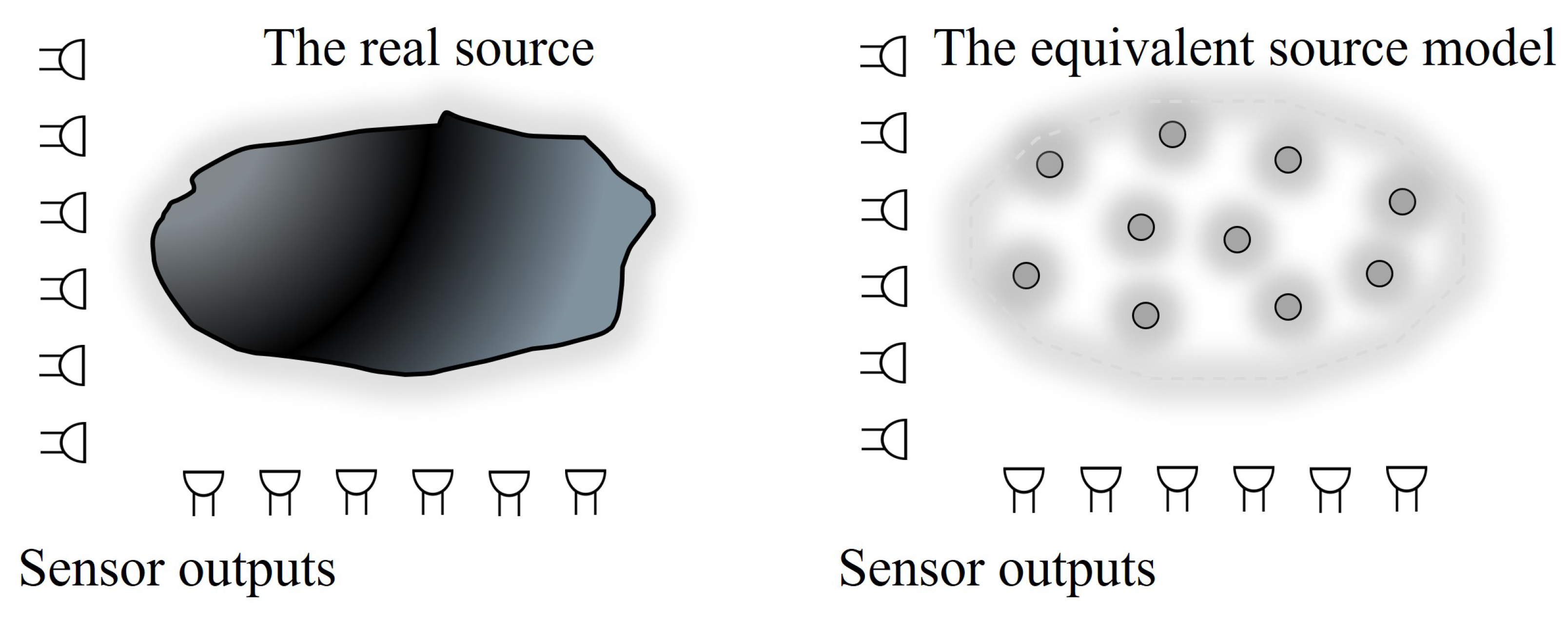
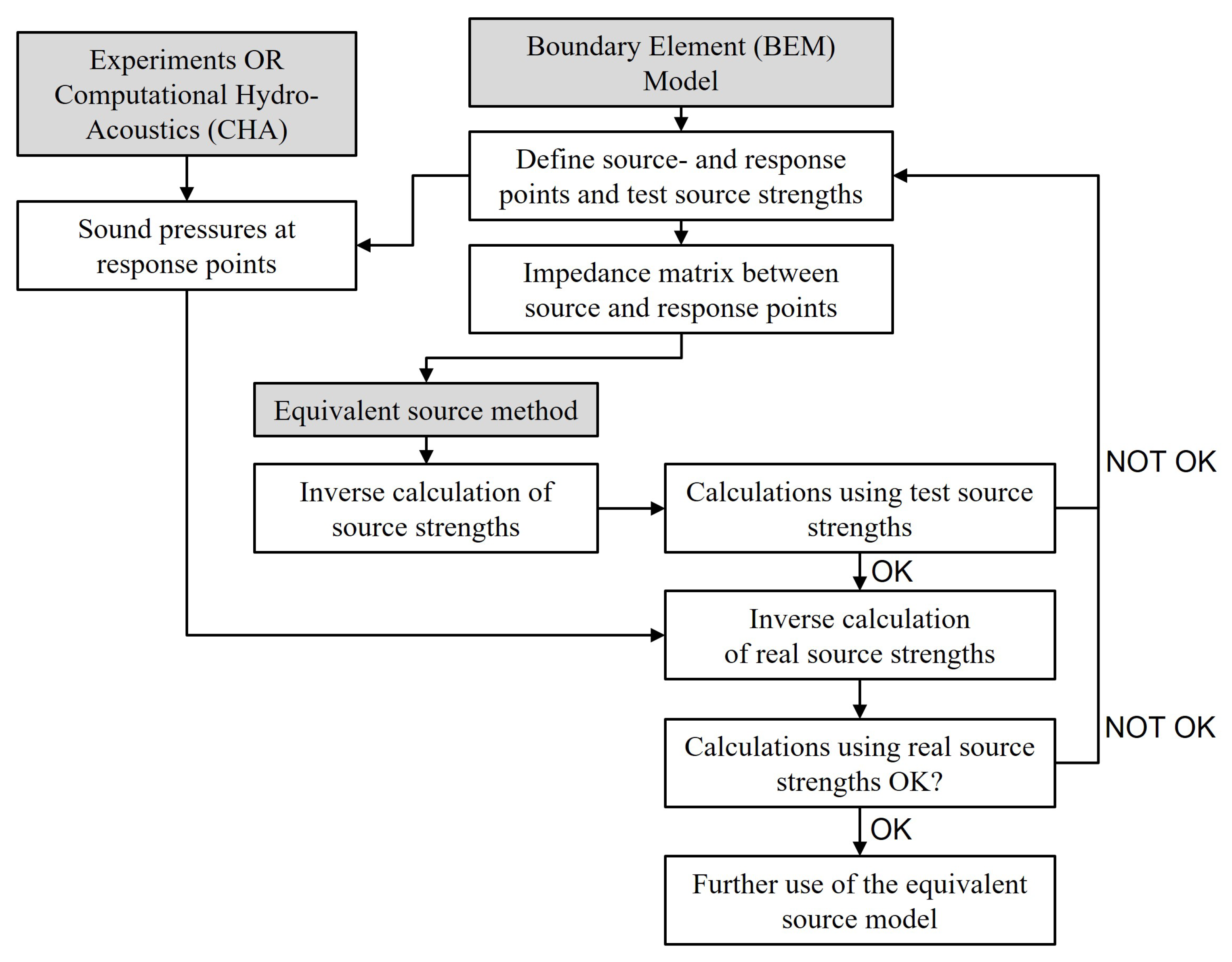
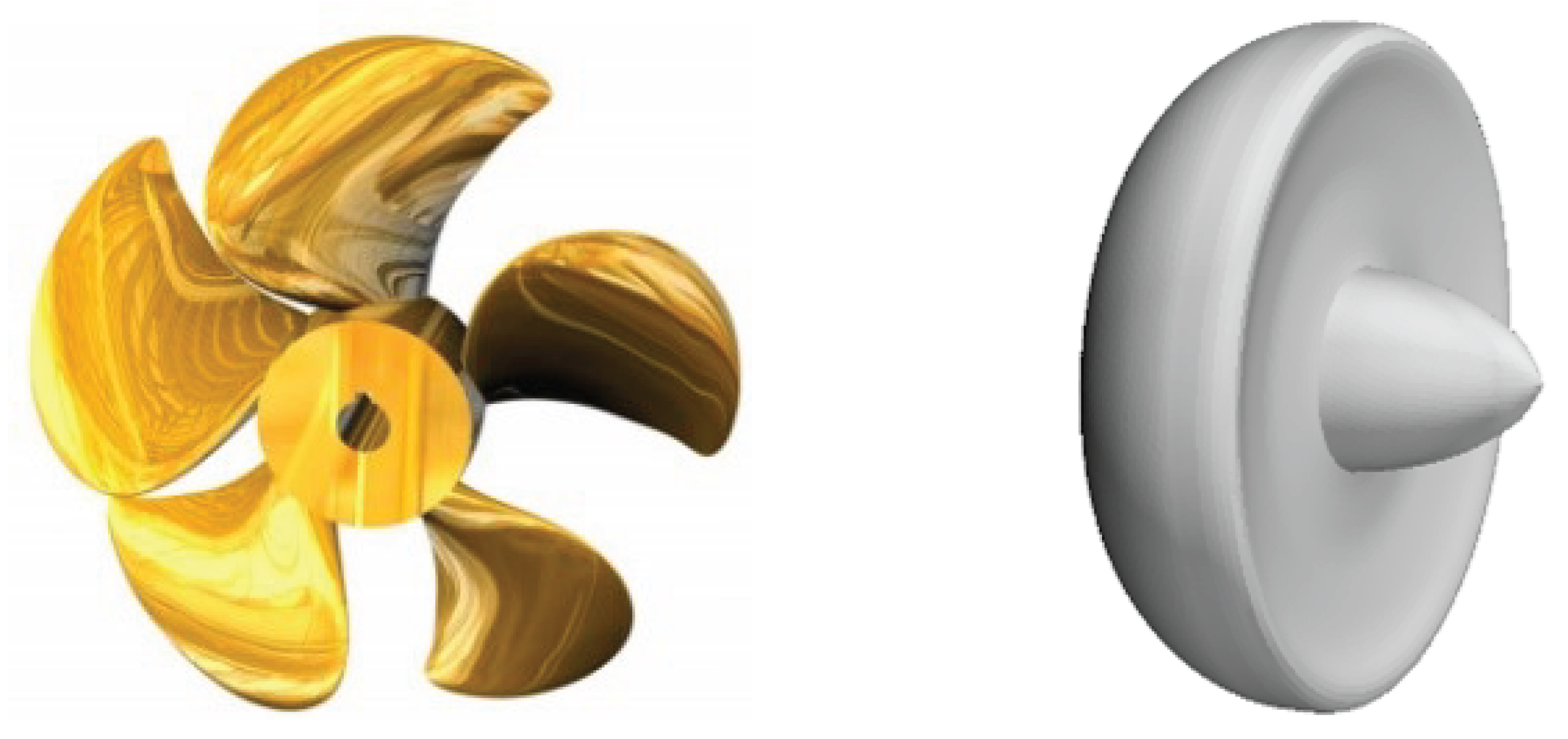

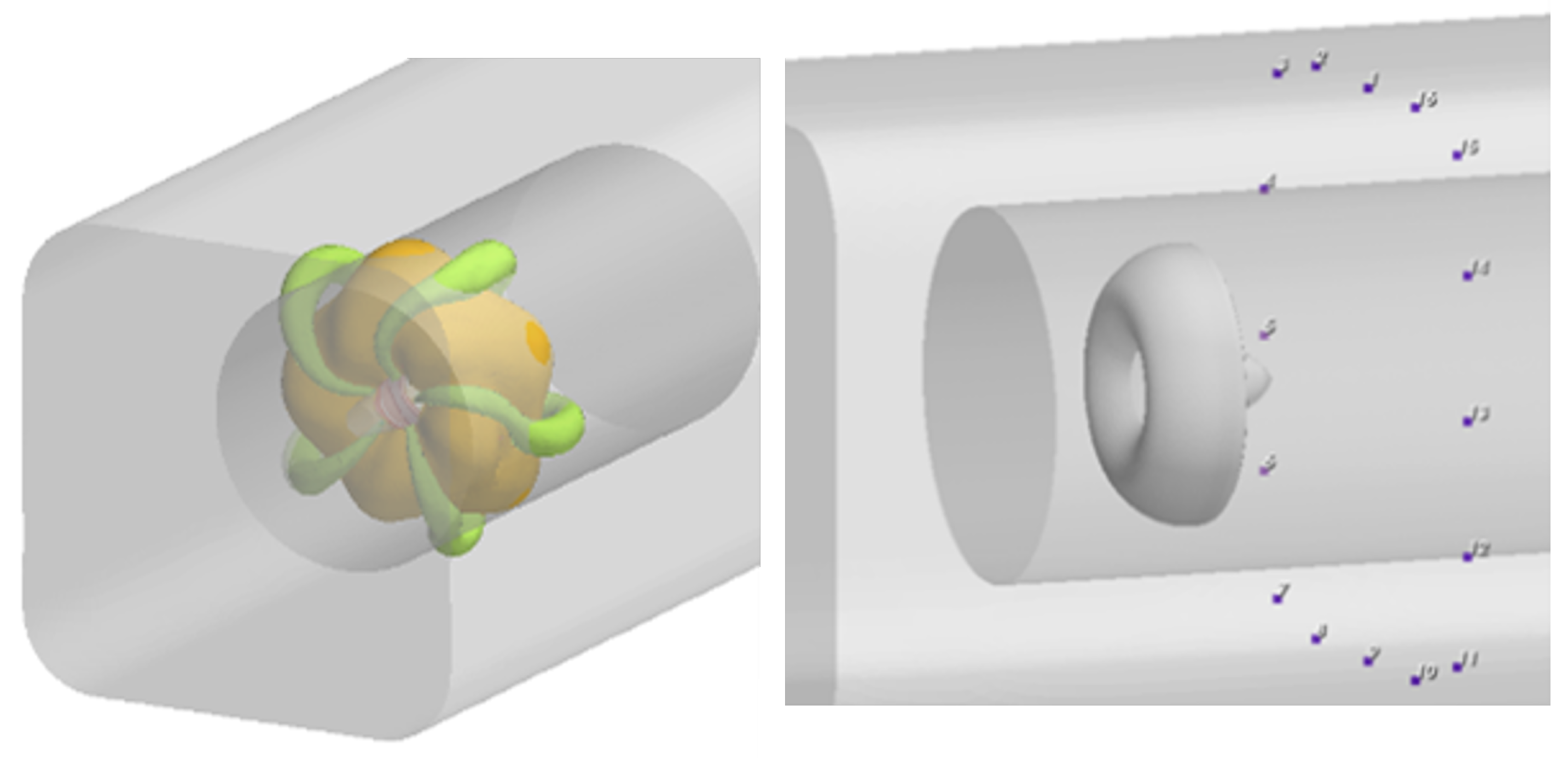
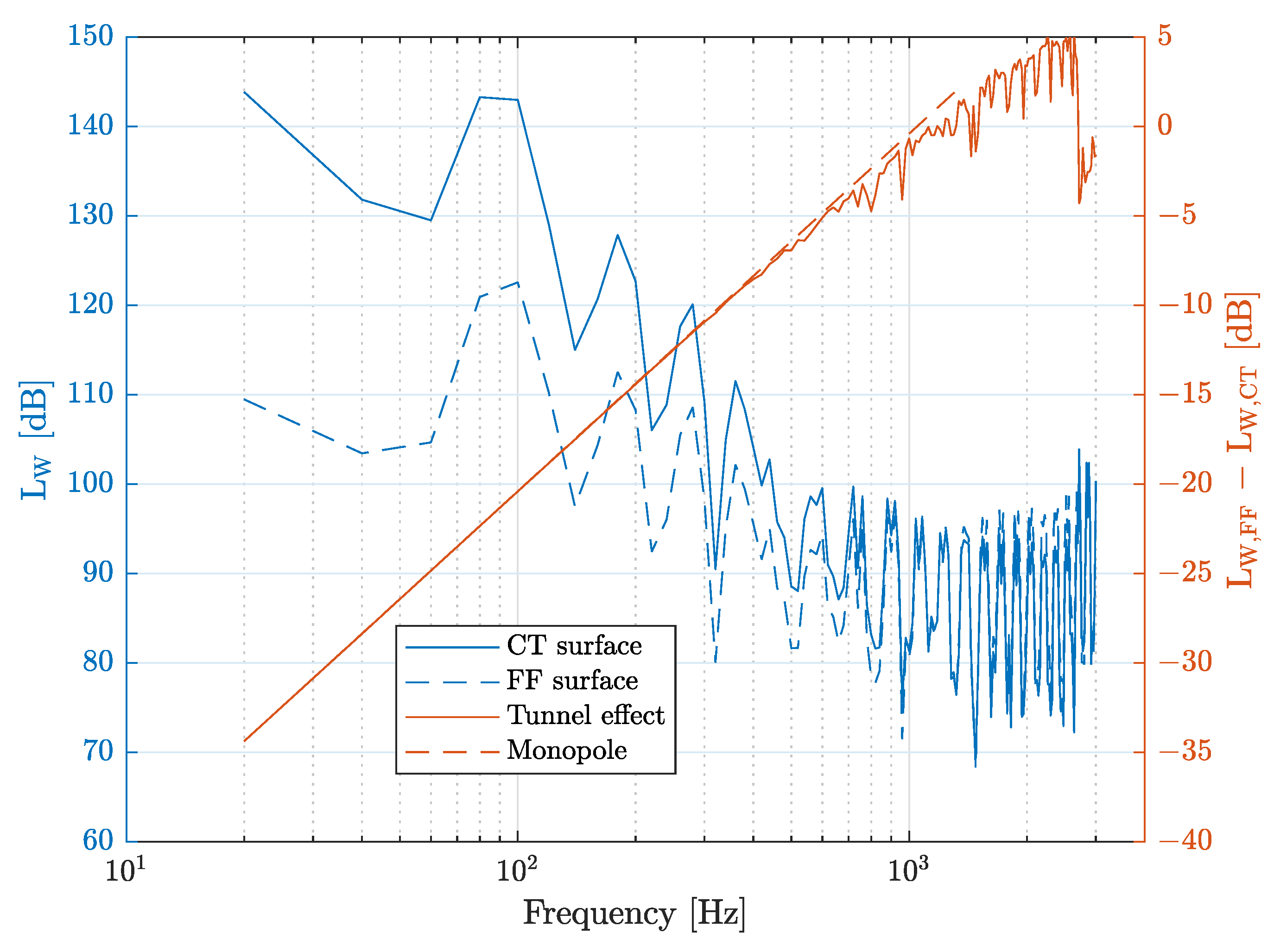

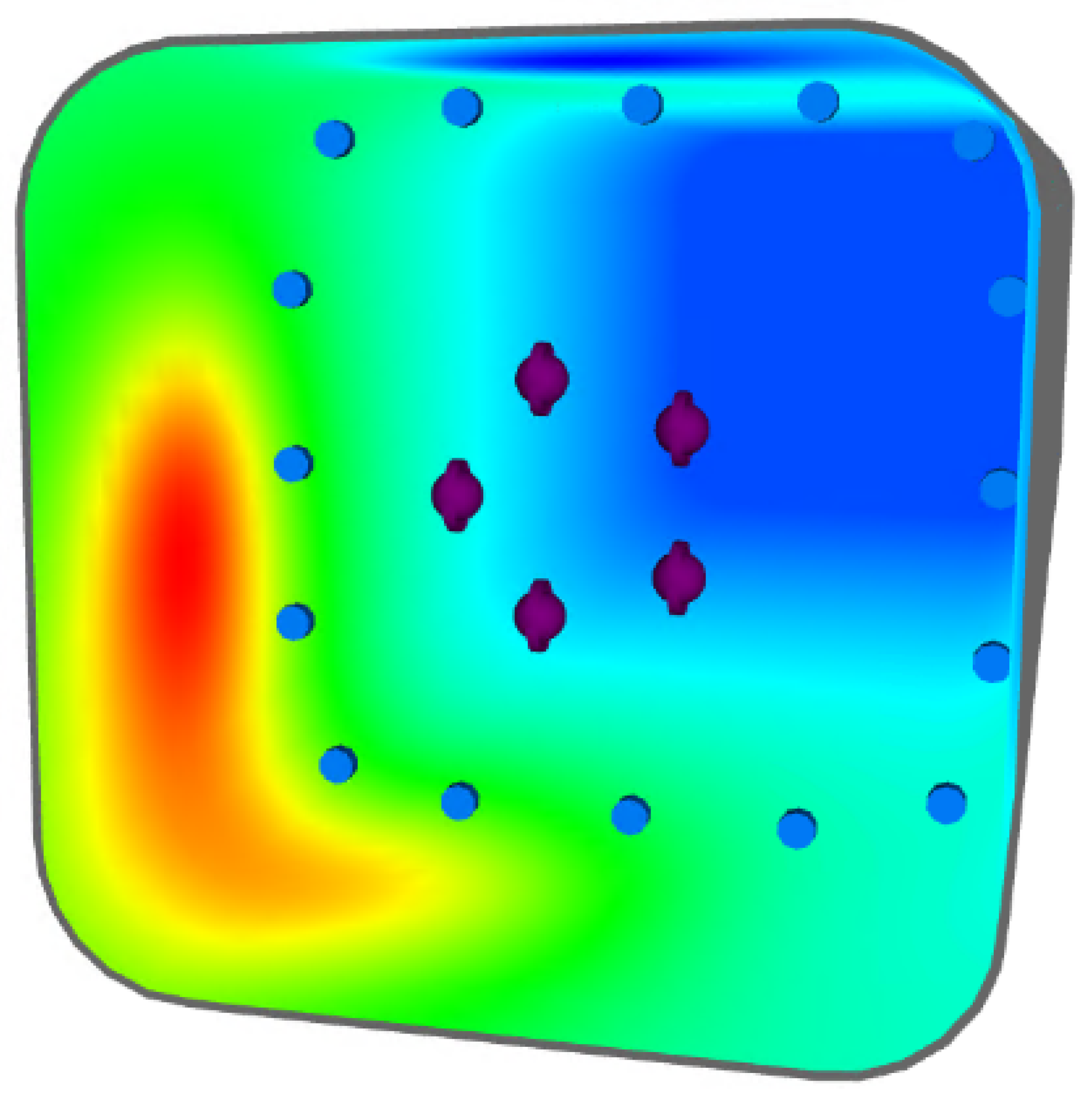
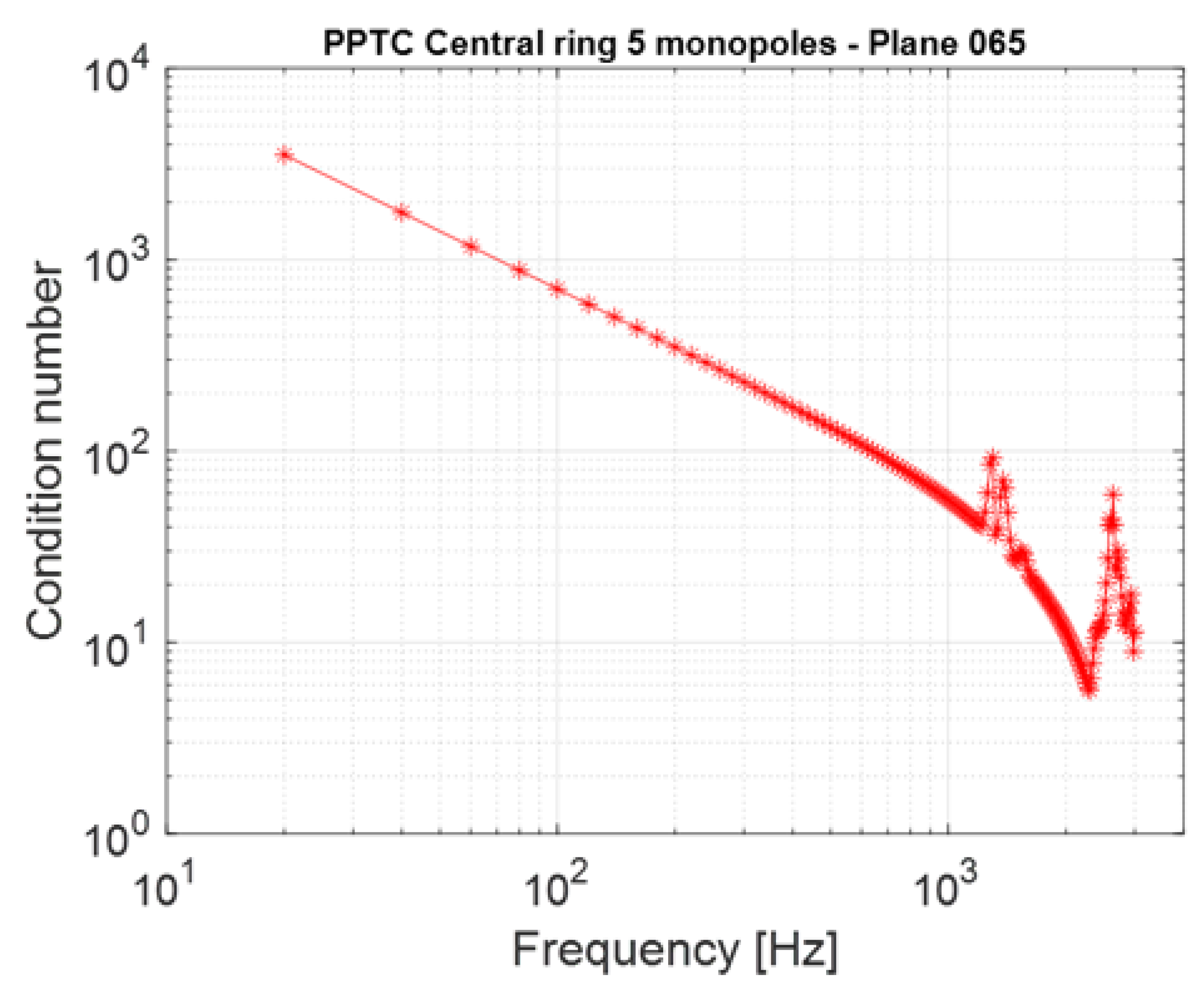
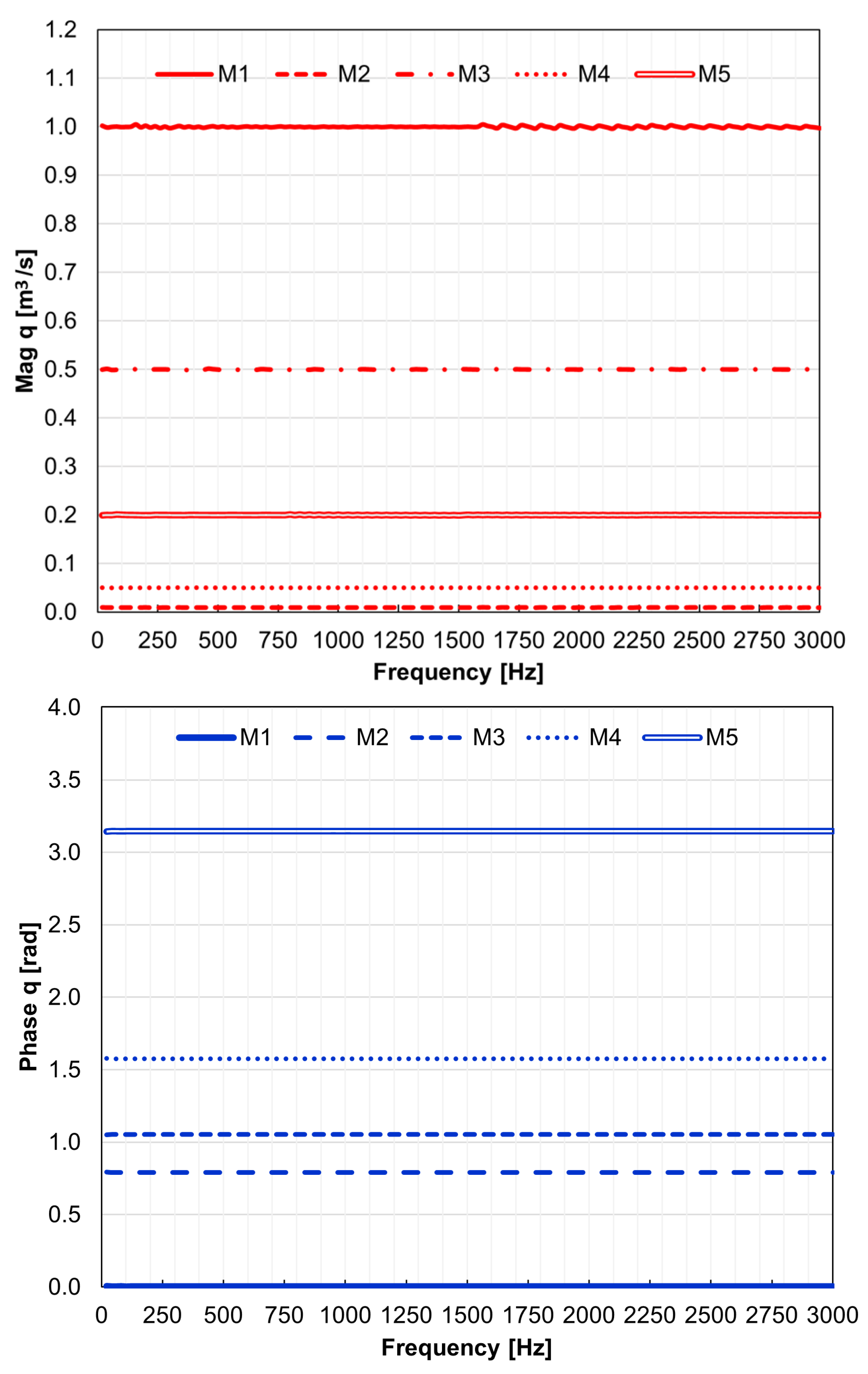


| Monopole Number | Magnitude of | Phase of [Radians] |
|---|---|---|
| 1 | 1 | 0 |
| 2 | 0.01 | |
| 3 | 0.5 | |
| 4 | 0.05 | |
| 5 | 0.2 |
Publisher’s Note: MDPI stays neutral with regard to jurisdictional claims in published maps and institutional affiliations. |
© 2022 by the authors. Licensee MDPI, Basel, Switzerland. This article is an open access article distributed under the terms and conditions of the Creative Commons Attribution (CC BY) license (https://creativecommons.org/licenses/by/4.0/).
Share and Cite
Tanttari, J.; Hynninen, A. Acoustic Source Characterization of Marine Propulsors. J. Mar. Sci. Eng. 2022, 10, 1273. https://doi.org/10.3390/jmse10091273
Tanttari J, Hynninen A. Acoustic Source Characterization of Marine Propulsors. Journal of Marine Science and Engineering. 2022; 10(9):1273. https://doi.org/10.3390/jmse10091273
Chicago/Turabian StyleTanttari, Jukka, and Antti Hynninen. 2022. "Acoustic Source Characterization of Marine Propulsors" Journal of Marine Science and Engineering 10, no. 9: 1273. https://doi.org/10.3390/jmse10091273





